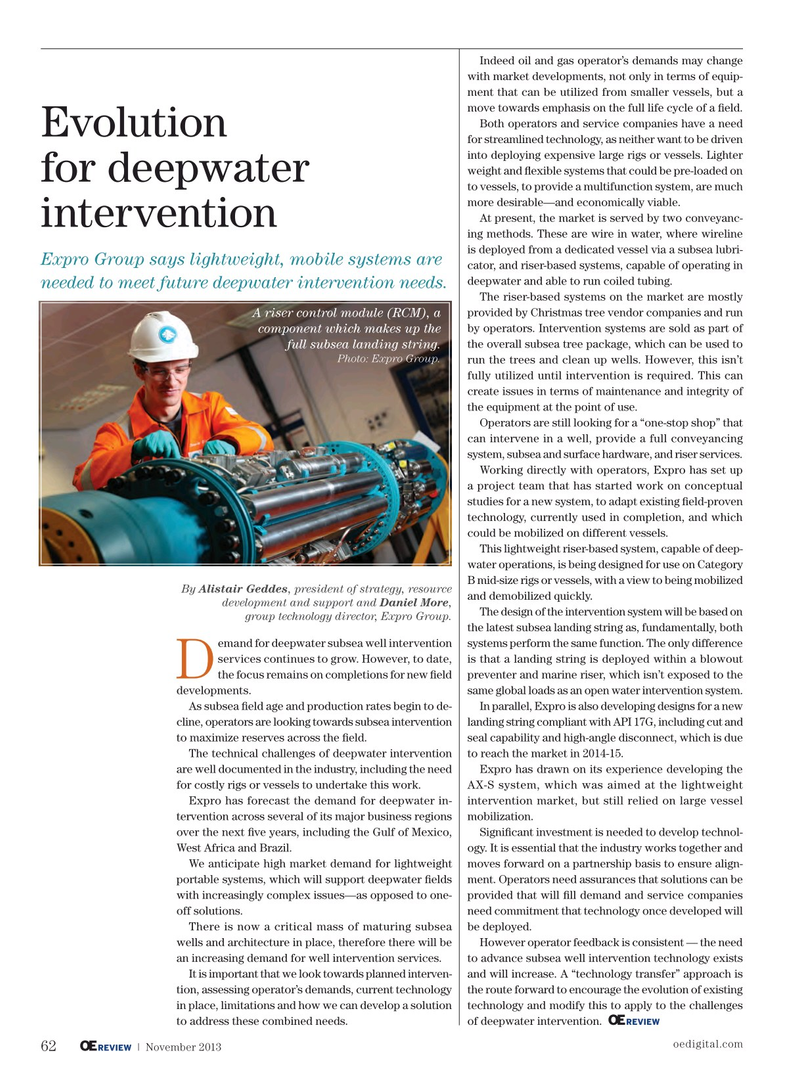
Page 60: of Offshore Engineer Magazine (Nov/Dec 2013)
Read this page in Pdf, Flash or Html5 edition of Nov/Dec 2013 Offshore Engineer Magazine
Indeed oil and gas operator’s demands may change with market developments, not only in terms of equip- ment that can be utilized from smaller vessels, but a move towards emphasis on the full life cycle of a feld.
Both operators and service companies have a need
Evolution for streamlined technology, as neither want to be driven into deploying expensive large rigs or vessels. Lighter weight and fexible systems that could be pre-loaded on for deepwater to vessels, to provide a multifunction system, are much more desirable—and economically viable.
At present, the market is served by two conveyanc- intervention ing methods. These are wire in water, where wireline is deployed from a dedicated vessel via a subsea lubri-
Expro Group says lightweight, mobile systems are cator, and riser-based systems, capable of operating in deepwater and able to run coiled tubing.
needed to meet future deepwater intervention needs.
The riser-based systems on the market are mostly provided by Christmas tree vendor companies and run
A riser control module (RCM), a by operators. Intervention systems are sold as part of component which makes up the the overall subsea tree package, which can be used to full subsea landing string.
Photo: Expro Group.
run the trees and clean up wells. However, this isn’t fully utilized until intervention is required. This can create issues in terms of maintenance and integrity of the equipment at the point of use.
Operators are still looking for a “one-stop shop” that can intervene in a well, provide a full conveyancing system, subsea and surface hardware, and riser services.
Working directly with operators, Expro has set up a project team that has started work on conceptual studies for a new system, to adapt existing feld-proven technology, currently used in completion, and which could be mobilized on different vessels.
This lightweight riser-based system, capable of deep- water operations, is being designed for use on Category
B mid-size rigs or vessels, with a view to being mobilized By Alistair Geddes, president of strategy, resource and demobilized quickly. development and support and Daniel More,
The design of the intervention system will be based on group technology director, Expro Group.
the latest subsea landing string as, fundamentally, both emand for deepwater subsea well intervention systems perform the same function. The only difference services continues to grow. However, to date, is that a landing string is deployed within a blowout
D the focus remains on completions for new feld preventer and marine riser, which isn’t exposed to the developments. same global loads as an open water intervention system.
As subsea feld age and production rates begin to de- In parallel, Expro is also developing designs for a new cline, operators are looking towards subsea intervention landing string compliant with API 17G, including cut and to maximize reserves across the feld. seal capability and high-angle disconnect, which is due
The technical challenges of deepwater intervention to reach the market in 2014-15.
are well documented in the industry, including the need Expro has drawn on its experience developing the for costly rigs or vessels to undertake this work. AX-S system, which was aimed at the lightweight
Expro has forecast the demand for deepwater in- intervention market, but still relied on large vessel tervention across several of its major business regions mobilization. over the next fve years, including the Gulf of Mexico, Signifcant investment is needed to develop technol-
West Africa and Brazil. ogy. It is essential that the industry works together and
We anticipate high market demand for lightweight moves forward on a partnership basis to ensure align- portable systems, which will support deepwater felds ment. Operators need assurances that solutions can be with increasingly complex issues—as opposed to one- provided that will fll demand and service companies off solutions. need commitment that technology once developed will
There is now a critical mass of maturing subsea be deployed.
wells and architecture in place, therefore there will be However operator feedback is consistent — the need an increasing demand for well intervention services. to advance subsea well intervention technology exists
It is important that we look towards planned interven- and will increase. A “technology transfer” approach is tion, assessing operator’s demands, current technology the route forward to encourage the evolution of existing in place, limitations and how we can develop a solution technology and modify this to apply to the challenges
OE REVIEW to address these combined needs. of deepwater intervention. oedigital.com
OE | November 2013REVIEW 62 062_OE1113_Dif_Expro.indd 62 10/28/13 2:07 AM

 59
59

 61
61